The genetics of Crested Geckos (Correlophus ciliatus), in contrast to that of other popular reptile breeding subjects, such as leopard geckos or ball pythons, has not yet been well understood or documented. It appears that the phenomenon of natural selection is working on multiple allelism, having multiple phenotypes. This may be an advantage to the species as there are many different traits that can be expressed, which lends itself to having more chances of adaptation and survival through generations.
Genetic Factors to Consider
It is relatively simple to determine the possible visual outcomes when breeding species whose genetics are primarily a function of dominance, recessiveness and co-dominance. It seems that with crested geckos, a multitude of genetic factors are concurrently in play:
Epigenetics (the study of changes in organisms caused by modification of gene expression) is a factor when incubation or environmental factors affect outcomes, and may or may not be heritable. For example, this occurs when low temperature/long incubation time increases tail pad and crest size. External and/or environmental factors, such as temperature, water and food can also affect how a gene is expressed. Ingestion of foods containing beta carotene (carotenoids) may affect the expression of colors on the red-orange-yellow spectrum.
Polygenetics is also likely to function to a larger extent in crested geckos than in other genera. This may lead to the continuous variation of traits that has been observed in crested geckos.
Individual heritable traits are most likely controlled by groups of several genes or what are referred to as “polygenes”. Each allele (specific gene) intensifies or diminishes the phenotype which is the observable characteristic and/or trait. Examples may include: the progression and diversity of pinstriping, having raised scales on dorsal ridges and forming lateral lines, the specific regions where portholes (potentially related) fall on the body, certain color variations, including base color matching (phantom) and the level and variation of expression in dalmations.
Expression of color in the dermal layers, whether by color and or structure, may look like a single phenomenon. In some (possibly many) instances it may actually be multiple expressions, which may be controlled by multiple alleles, that are overlaid and create a single visual appearance. The singular trait and/or color designation (for example buckskin, green, brindle, harlequin, etc.), that we, as hobbyists, use to describe crested gecko morphs, probably more often than not, will be far from the multitude of factors that contribute to it.
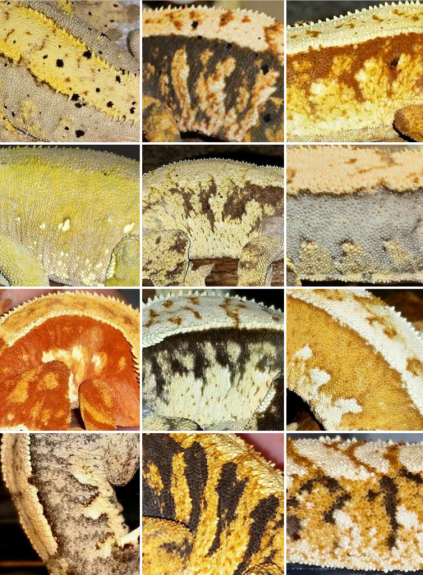
,,
Color and Pattern
Consider the base (body) colors yellow, red, and orange. Yellow and red may be considered “primary” base colors, and, when expressed together, can yield an orange base color result.
The crested gecko’s pattern (flame, harlequin, etc.) is overlaid onto the body’s base color.
I have found that yellow base color inhibits the orange dorsal and lateral flame/harlequin pattern, rendering the pattern white, whereas orange base color does not. Does this happen because the red, which combines with and alters the yellow to orange, takes control and allows the orange pattern to be visual?
If a yellow and cream extreme is bred to a Halloween extreme (orange pattern on black base color), can the pattern become white by picking up the trait from the yellow animal and still retain the black base color of the Halloween? In other words, could this pairing produce a black base color with white extreme patterning? One can only theorize that it would be possible if red was not present in the black base color expression.
The Breeding Experiment
These observations have led me to look for a loophole. I produced an orange based male with a large percentage of orange flame/harlequin patterning. Currently, I see it as a potential intermediary animal. Yellow and red are being expressed with dominance of pattern from red, while the yellow is present to create the orange color. I believe that multiple alleles are probably responsible for different tones of each color, not negating some variance within each potential allele.
With this in mind, I have to ask, is there a single allelic expression within the group that can be isolated to allow for an orange pattern expression to be present on a yellow animal without any red influence? This leads me to speculate, is a specific red expression necessary and the single controlling factor?
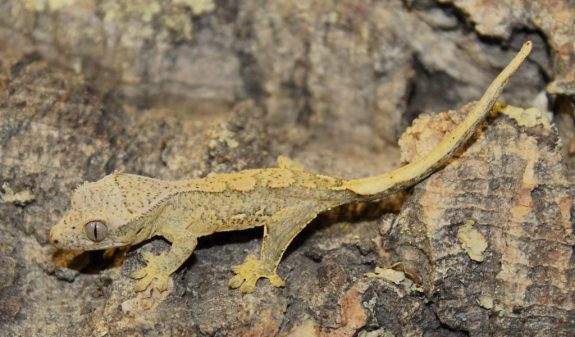
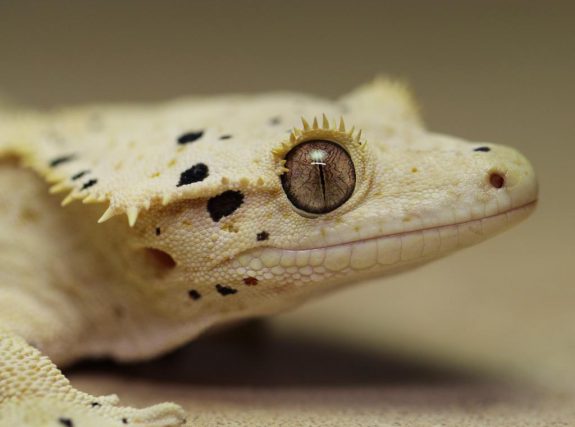
Over the past two years that I bred Mr. White, a pale yellow to opaque white (in terms of firing range) to three black based females from the Pangea Triple X Halloween line, I was not successful in producing pale based animals with orange saddled stripes. This upholds my theory that yellow based animals cannot have orange pattern expressions (with the exception of brindle and tigers). I also proved something else: of twenty-two animals produced, one hundred percent have a yellow base, and any pattern present, aside from some outlining, is white or cream. The simple fact that there is no variation from the yellow base gives validity to the dominance of yellow within Mr. White.
Experienced breeders have seen some level of color dominance in yellow crested geckos, but most likely not to this degree. The next phase of experimental breeding will be to use the aforementioned orange on orange male and breed him to some of Mr. White’s daughters. This is simply a path to test the strength of the dominant yellow and the red that lies within the orange base. If red base color will allow the expression of orange patterning, I would hope that the offspring of the orange on orange male would yield some yellow geckos with orange patterning. Ultimately, I would like to establish this as a the loophole to create an orange flame/harlequin pattern on a yellow gecko. However, if I don’t achieve the desired results, it will add to the strength of my theories about yellow and red.
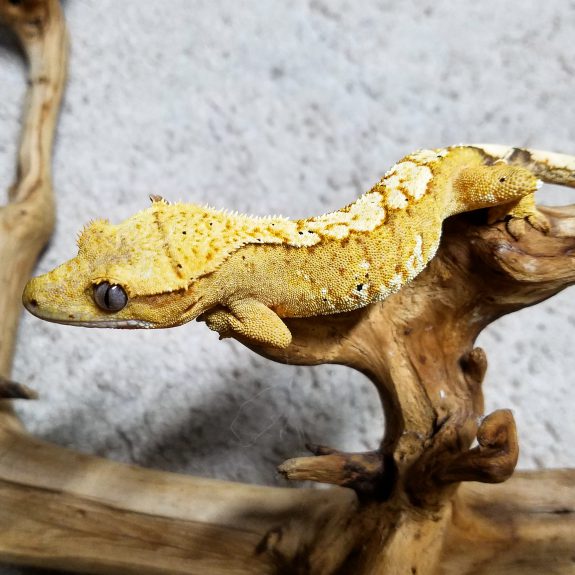
There are also animals that exhibit a hypo like diluting affect to their base colors… but that’s another set of experiments!
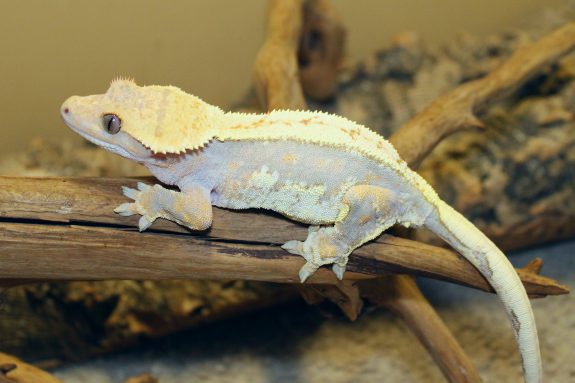
Stay tuned!


My notes, theories and questions are perpetually changing with new observations coming almost daily. Breeding experiments, to test theories, are a major part of my projects.
Through observation, sharing information and brainstorming, we as a community can begin to understand the diverse expressions within this species. I shared some of my notes so that we may be able to brainstorm together and move forward in our common endeavor.
I’m so curious about this and I’m glad someone is looking into it more. I would love to have a better understanding of the genetics of these guys for my pairs. I currently have one egg from a pairing of a gray (when fired up) male to a red female bi color and I can’t wait to see what comes out of the egg since both the parents are opposites on the color spectrum. Thanks for putting in the work to get to the bottom of this!
Also if you could add any notes about how structure is passed down that’s an important factor too. What I’ve read is if one parent has sub-par structure and one has great structure then you get sort of an in between? I don’t know how much water that holds but it’s definitely not talked about enough.
Structure appears to be genetic and can be affected by incubation temperatures. If you don’t know the temps your animals were incubated at and/or their genetic disposition to having good structure… you are.starting at ground zero with any animals you put together. I notice that the crest sizes range, but some sires tend to produce larger crests at a higher percentage than others. These are great animals to start projects with.
I only bring it up because I have a yellow male I’d like to pair but likely won’t because he has literally no structure (he looks like a garg lol) and that’s not a trait I (or anyone else I’d imagine) would want to be breeding in. I like good structure but really don’t like the crazy droopy crests because it seems like overkill and I just don’t find it all that attractive.
I actually happen to have a yellow based male with orange partial pin striping and orange harlequin markings. He has white portholes, which I thought would eventually spread, but he’s continued to hang on to his orange markings, and is now around 14 grams. His back is more light orange but his side markings are definitely orange on yellow
Hi Grace, I would like to see this gecko, fired up and down, if possible. Can you post it on a forum or somewhere that I could see it?
Yes! I have photos of him on my Facebook page. Here is one from when he was around 8 grams and fired up
https://m.facebook.com/photo.php?fbid=827090630733814&id=817913108318233&set=a.818907281552149.1073741830.817913108318233&source=54
Working on getting more now since I just got him back and he’s 14 grams now. Still looks pretty much the same
The base has a yellowish hue, but it is not a yellow base. The dark hase coloration on the face and leg are the telling clues. I think you will be able to tell better when it reaches adulthood and really fires up.
Ah you’re right, I finally got him to fire down and his base is actually more of a pinkish red, which is why he fires orange.
And I see now what you’re looking for- you’re talking about the orange Halloween extreme markings on a solid yellow body?
One thing I’m hoping to research more is the genetic result of red and cream with an olive phantom pairing. I have a female that happens to be one of the best red and creams I’ve ever seen. Her dad was a low pattern olive and mom was solid red with white portholes.
Cresteds are definitely the most interesting species when it comes to breeding- I’m almost glad we can’t exactly determine like we can in ball pythons and leopard geckos. Makes things a lot more interesting.
Things might get a little muddy, with olives and reds together, but each animal is unique and hopefully you will find a pattern of inheritance in your animals. I’m also playing with red and white. This is Rime…
https://www.instagram.com/p/BJh4MJHAjG2/